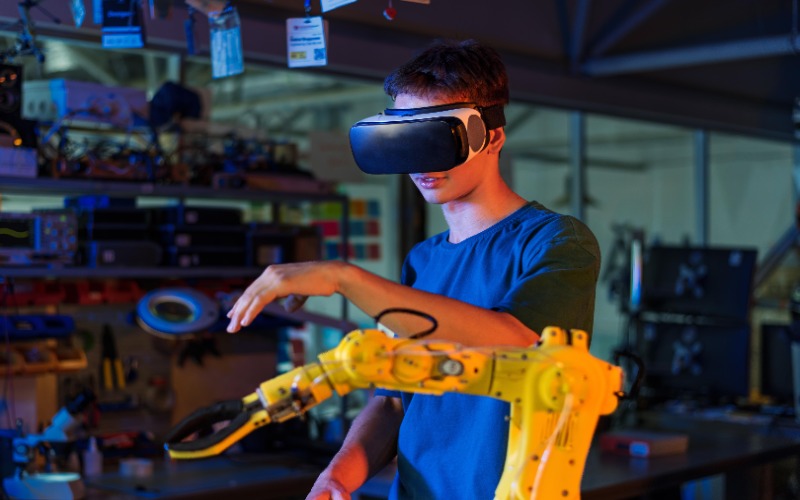The idea of an immersive virtual reality where humans interact as avatars in a simulated environment may seem a little out there for most people. Yet today, the benefits of the industrial metaverse — where the physical and the digital come together, boosted by the power of artificial intelligence (AI), machine learning (ML), high-performance networks, the cloud, virtual/augmented and extended reality (VR, AR and ER), and 5G/6G connectivity — are beginning to solidify.
And it’s the business value of the use cases that’s making the difference.
Indeed, the recent research with EY shows that businesses are starting to embrace the potential of this augmented world. Eighty-percent of experienced respondents indicated they believe that the industrial metaverse will have a significant or transformative impact on their business. And those companies who have already deployed use cases report more benefits than those in the planning phase say they expect to experience.
The digital twin is emerging as a flagship application of the industrial metaverse. It’s a digital representation of a physical system or environment. It contains physical and procedural properties and conditions and can integrate real-time data and simulations.
3D and PLM market leader Dassault Systèmes refers to this as “virtual twin experiences.” In one of their recent showcases for equipment manufacturers, visitors entered a giant hall, strapped on a pair of smart goggles and a backpack loaded with PCs, batteries, sensors, and actors.
With this equipment, they experienced the virtual world in real-time by immersing in a 360-degree, 3D model of a shop floor containing real-time production and equipment performance data. Visitors could experiment and understand how a virtual platform can improve the simulation and decision-making process and reduce the costs of ineffective operations.
Turns out, this is the kind of application industries are craving.
They can work with real-world data sets and testing algorithms on a virtual testbed. Use cases like schedule and capacity planning, onboarding new team members, and visualizing predictive maintenance make virtual R&D one of the most cited value-creating use cases for the industrial metaverse.
By offering visualization, data interoperability, and interwoven digital-physical worlds, teams can engage in prototyping and testing, facility planning and optimization, supply chain, grid or network planning and optimization, and predictive maintenance. All of which can save time, money, and effort while ensuring staff and the environment are protected.
What’s Driving the Metaverse
So, why now? COVID-19 proved a clear inflection point, a disruptor that forced remarkable changes in how we work. Combine that with inflation, supply chain issues, skill shortages, safety requirements, and climate change.
That’s why business value is the clear driver for industrial metaverse adoption.
The concept of virtual reality harkens back a century. By 1968, Ivan Sutherland and his student Bob Sproull had unleashed a VR/AR head-mounted display so heavy it was nicknamed “Sword of Damocles.” Such a forbidding moniker must have given researchers pause. Since then, there’s been much adjusting and refocusing. Enough that now, use cases are emerging with real heft and business viability. Fifty-eight percent of respondents in the EY survey have already piloted or deployed a metaverse use case.
Imagine a railway operator’s face lit by the thousand tiny dots traversing a 360-degree visualization of the nation’s railway system on a wall of screens before him. Some dots are trains departing stations as frequently as every three minutes and traveling up to 400 kilometers an hour. Others provide signaling data, while still more are alarms blinking between red, yellow, and green to indicate performance metrics or areas of concern.
It’s the peak of summer tourist travel, the capital city is hosting the Olympic games, and the entire nation is in the grips of torrential rainfall. As the operator adjusts routes for the time it takes a train to brake — up to three kilometers in normal conditions, another kilometer on a wet track — a cargo train derails, and the entire system is immediately in the red zone.
Not the best time for an equipment switchover, but that’s why they’re trialing it — right here in the VR training room. Conjure the worst, and the operator and his team of engineers can simulate it using a digital twin of the nation’s railway network.
A virtual testbed for a mission-critical industry like railways — where there is zero tolerance for error — means they can prepare for the worst of the unknowns.
Digital twinning also applies in the world of medical research. Envisage a virtual lab, where a digital replica of the human vascular network is displayed on a vast screen, and a team of XR headset-wearing phlebologists are injecting a test antidote into the on-screen subject, compiling data, modifying parameters, and simulating algorithms. With cardiovascular diseases the leading cause of death globally, this research can lead to life-altering breakthroughs.
Extend this into the area of vaccine testing or assessing side effects of new drugs for individual patients, and we can change the face of medicine.
Next Up in the Metaverse
Still, these are early days for metaverse use cases.
For the market to grow to the “$100 billion by 2030” forecast by ABI Research, industries will need a robust network foundation built on multi-access connectivity and high-speed computing functions. Secure, ultra-fast networks with low latency and high reliability will power the industrial metaverse and keep mission-critical applications online. Even the most advanced 5G networks will be tested by the requirements of the metaverse, and the work on 6G is already in full swing.
Regardless of the technology, it’s still humans behind the metaverse. Partnerships will be critical as the integration requires high levels of internal skill and external collaboration to succeed.
Look for a partner who brings to the table technology leaders, system integrators, global service providers, and industry specialist partners around the world. That kind of powerful team can help realize the new apps and solutions that will drive true business value.











